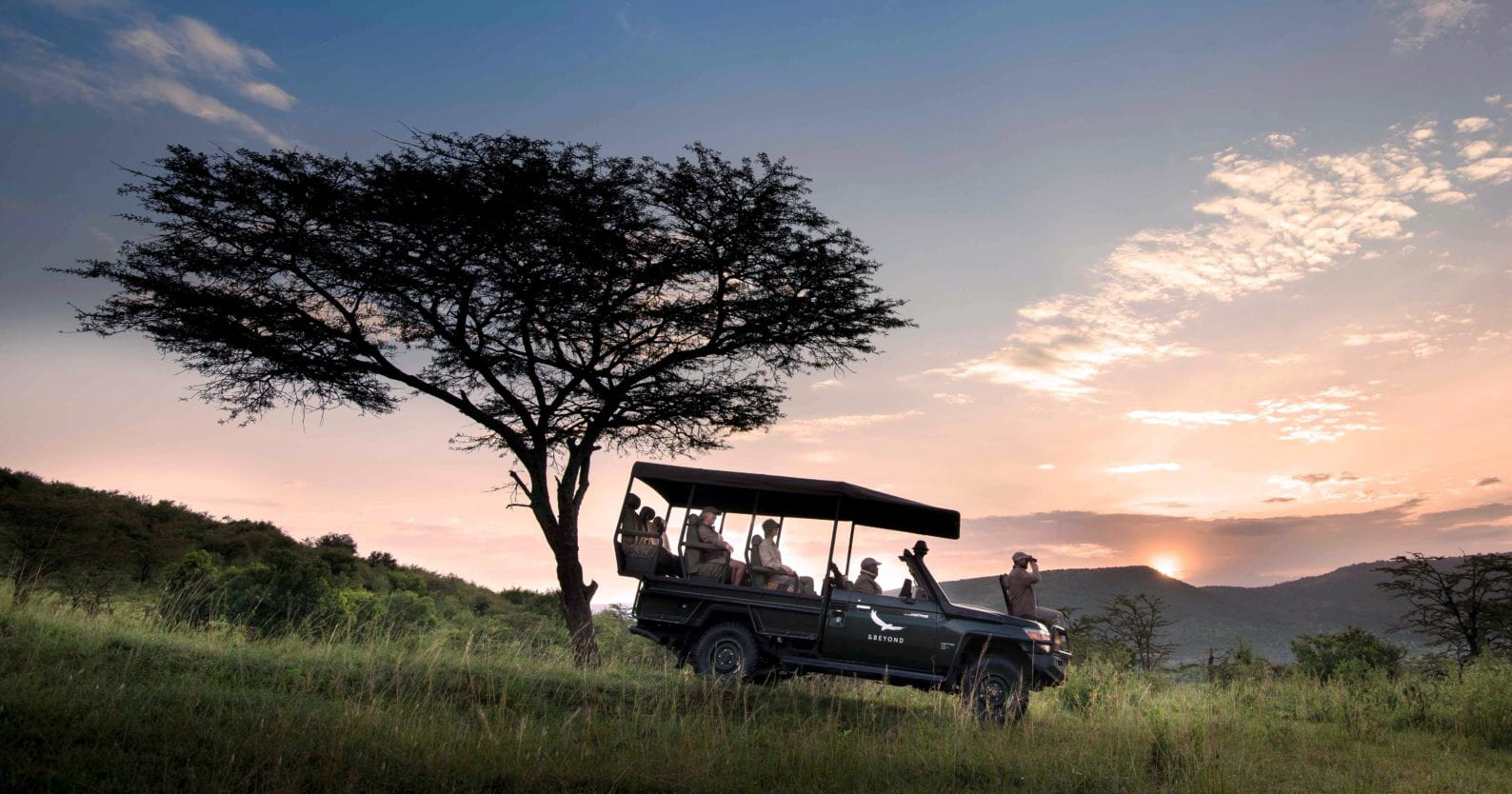On this page, you will find all the information about the top 5 national parks included in the various Expedition Kilimanjaro Safaris.

The Top 5 in short?
A small but beautiful park, Arusha National Park is closest to both the famous African “safari city” of Arusha (29 km/18 miles away) and Kilimanjaro International Airport, making it ideal for day trip safaris. Wildlife is abundant here, and it is one of Tanzania’s most beautiful and topographically diverse game reserves.
The Tarangire River provides the only permanent water in the area, serving as a “dry season refuge” for the animals of Tanzania’s southern Masailand. Tarangire National Park is renowned for hosting some of the largest elephant herds in Tanzania, or even Africa. A safari to Tarangire National Park is included in the 3-day, 5-day, and 6-day safari options.
Lake Manyara National Park is one of Tanzania’s most dramatic wildlife areas, with the most visible predators around Lake Manyara. The main attraction is the lions, famous for their habit of climbing trees. This park is included in all multi-day safaris.
Ngorongoro Crater has an almost mystical ring to its name and is one of the most densely populated wildlife areas in the world, home to an estimated 30,000 animals within a 30-square-kilometer volcanic crater. This park is part of all multi-day safaris.
Serengeti National Park is home to the annual migration of wildebeest across the grassy plains, undoubtedly the greatest wildlife spectacle in the world. This park is iconic for East Africa and more specifically Tanzania. A visit to the vast Serengeti plains is available in the 4-day, 5-day, and 6-day safari options.
About the national parks

The main role of Tanzania’s national parks is conservation. The 14 national parks, many of which form the core of a much larger protected African ecosystem, are set aside to preserve the country’s rich natural heritage and provide safe breeding grounds where wildlife can thrive, safe from the competing interests of a growing human population.
The existing park system protects a number of internationally recognized bastions of biodiversity and UNESCO World Heritage Sites, restoring the balance for those areas of the country affected by deforestation, agriculture, and urbanization. The Tanzania National Parks organization is also currently acquiring more land to expand some parks, and to raise the status of traditional migration corridors linking protected areas.
By visiting Tanzania, you are supporting a developing country’s extraordinary investment in the future. Despite population pressure, Tanzania has set aside more than 42,000 square kilometers for national parks. With other reserves, conservation areas, and marine parks added, Tanzania has given more than a third of its territory some form of formal protection – a much higher proportion than most of the world’s richer countries.
The Top 5 explained in detail
Arusha National Park

Arusha National Park, the closest national park to the city of Arusha—the safari capital of northern Tanzania—is a multi-faceted gem that offers a rich variety of habitats to explore within a single day trip.
Upon entering, visitors are greeted by the shady mountain forest, home to curious blue monkeys and the vibrant turacos and trogons. This is the only place in the northern safari circuit where you can easily spot the acrobatic black-and-white colobus monkey. Nestled within the forest lies the spectacular Ngurdoto Crater, with its steep, rocky cliffs encircling a wide swampy plain inhabited by herds of buffalo and warthogs.
Further north, the rolling grassy hills frame the serene beauty of the Momela Lakes, each displaying different shades of green or blue. These lakes are sometimes tinged pink with thousands of flamingos, and they host a rich array of native and migratory waterbirds. Shaggy waterbucks with their large lyre-shaped horns graze at the water’s edge, while giraffes glide gracefully over the grass-covered hills among grazing zebra herds. Pairs of wide-eyed dik-diks dart through the thickets like out-of-control hares on spindly legs.
Although elephants are rare in Arusha National Park and lions are absent, visitors can spot leopards and spotted hyenas prowling during the early morning and late afternoon. It is also at dusk and dawn that the veil of clouds on the eastern horizon lifts, revealing the majestic snow-capped peaks of Kilimanjaro just 50 km away.
Dominating the park’s horizon is Kilimanjaro’s humble cousin, Mount Meru—Africa’s fifth highest peak at 4,566 meters. With its peaks and eastern foothills protected within the national park, Meru offers unrivaled views of its famous neighbor while being a rewarding hiking destination in its own right.
The ascent of Meru begins through forested savannah, where buffalo and giraffe are commonly found, and continues to forests rich with red-hot pokers and draped in Spanish moss. The journey reaches the high open heath adorned with giant lobelias and everlasting flowers clinging to the alpine desert. Delicately shaped cliff jumpers mark the progress of the hike. The steep summit reveals Kilimanjaro, bathed in the blush of sunrise—a sight to behold.
Size 137 km²
Location North Tanzania, northeast of the city of Arusha.
Accessibility An easy 40-minute drive from Arusha. About 60 km from Kilimanjaro International Airport. The lakes, forest and Ngurdoto crater can all be visited on a day safari.
To do Forest walks, numerous picnic spots
Best time to climb Mt Meru: June-February, although it can rain in November. Best views of Kilimanjaro in December-February.
Accommodation The Arusha National Park is only offered as a day trip from the hotel in Arusha.
Tarangire National Park

Under the bright sun, the landscape of Tarangire National Park transforms, with the earth turning dusty red and the withered grass becoming as brittle as straw. The Tarangire River, now a shadow of its wet season glory, continues to attract a remarkable concentration of wildlife. Thirsty nomads travel hundreds of parched kilometers, drawn by the river’s reliable water supply.
Herds of up to 300 elephants scour the dry riverbed for underground streams, while migrating wildebeest, zebra, buffalo, impala, gazelle, hartebeest, and eland gather around the shrinking lagoons. This park boasts the largest concentration of wildlife outside the Serengeti ecosystem, providing a veritable feast for predators. It is the only place in Tanzania where dryland antelopes, such as the stately fringe-eared oryx and the peculiar long-necked gerenuk, are regularly observed. During the rainy season, these seasonal visitors spread over a vast 20,000-square-kilometer area until the green plains are exhausted and the river calls them back. However, Tarangire’s elephant groups are always easy to find, whether wet or dry. The park’s swamps, tinged green year-round, host 550 bird species, the most breeding species in a single habitat in the world.
On drier ground, you can encounter the Kori bustard, the heaviest flying bird species, and small flocks of ground hornbills that bellow like turkeys. Bird enthusiasts will delight in spotting screeching flocks of the dazzlingly colorful yellow-collared lovebird, and the more subdued rufous-tailed weaver and ashy starling—all endemic to the dry savannah of north-central Tanzania. Disused termite mounds often attract colonies of the endearing pygmy mongoose and pairs of red-and-yellow barbets, which draw attention with their loud, bell-like duets. In Tarangire, you might even spot pythons, as well as lions and leopards, lazing in the branches of sausage trees, their tails playfully concealed among the tree’s fruits.
Size 2,600 km².
Location 118 km southwest of Arusha.
Accessibility Easy drive from Arusha or Lake Manyara on a paved road up to 7 km from the main entrance; you can continue to Ngorongoro Crater and the Serengeti. Charter flights from Arusha and the Serengeti.
Best time Year-round, but dry season (June-September) for the large numbers of animals.
Accommodation When visiting Tarangire National Park, you will be accommodated at the Flamingo Lodge (photo) or the Nsya Lodge.

Lake Manyara National Park
Stretching for 50 km along the foot of the 600-meter-high rust-gold Rift Valley escarpment, Lake Manyara is a picturesque gem that Ernest Hemingway hailed as “the most beautiful I had seen in Africa.”

The compact game viewing route through Manyara offers a microcosm of the Tanzanian safari experience. From the entrance gate, the road winds through a lush, jungle-like groundwater forest. Here, hundred-headed troops of baboons stand nonchalantly by the roadside, blue monkeys scurry deftly among the ancient mahogany trees, dainty bushbucks walk cautiously through the shadows, and outsized forest hornbills cacophonously honk in the high canopy.
Contrasting with the intimacy of the forest are the grassy plains and sweeping views to the east, across the alkaline lake, to the jagged blue volcanic peaks rising from the endless Maasai steppes. Large herds of buffalo, wildebeest, and zebra gather on these grassy plains, along with giraffes—some so dark in color they appear black from a distance.
Inland from the floodplains, a narrow belt of acacia forests is the favorite haunt of Manyara’s legendary tree-climbing lions and impressively tawny elephants. Squadrons of banded mongooses shoot between the acacias, while little Kirk’s dik-diks forage in their shade. Pairs of cliff jumpers can often be seen silhouetted on the rocks above, with hot springs steaming and bubbling beside the lake shore in the far south of the park.
Manyara is the perfect introduction to Tanzania’s birdlife. More than 400 species have been recorded, and even a first-time visitor to Africa can reasonably observe 100 in a single day. Highlights include the thousands of pink flamingos on their perpetual migration and other large waterfowl such as pelicans, cormorants, and storks.
Surface area 330 km², including up to 200 km² more at high water levels.
Location In northern Tanzania. The gateway is 1.5 hours (126 km) west of Arusha along a newly tarred road, close to the ethnically diverse market town of Mtowa Mbu.
Accessibility By road, charter or scheduled flight from Arusha, en route to Serengeti and Ngorongoro Crater.
To do Game drives, canoeing if water levels are high enough. Cultural tours, mountain bike rides, abseiling and hillside forest walks outside the park.
Best time Dry season (July-October) for large mammals; wet season (November-June) for birdwatching, the waterfalls and canoeing.
Accommodation If you visit Lake Manyara National Park, you will be accommodated at the Lake Burunge Tented Lodge, a particularly fine tented camp with 20 luxury tents and 30 rooms.
The lodge features a central dining pavilion and several beautifully decorated huts, offering a serene and immersive safari experience. For safety reasons, walking between these accommodations on your own is not allowed after dark. Guests must ask one of the guards to accompany them. This precaution is essential, as it is not uncommon for a stray lion to choose a veranda as a resting spot for the night. This is a serious matter and highlights the unique and wild environment in which the lodge is situated.

The Ngorongoro Crater
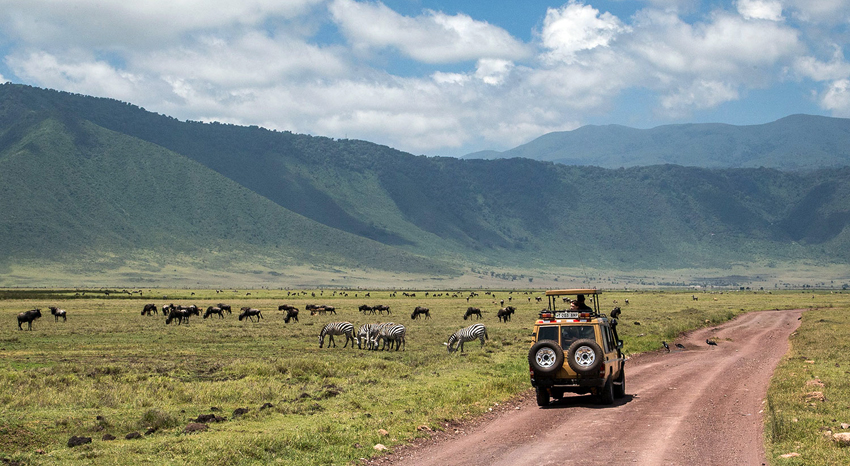
The Ngorongoro Crater, often referred to as “the Eden of Africa” and the “8th Natural Wonder of the World,” is a must-visit destination for tourists coming to Tanzania. This world-class attraction offers breathtaking scenery and unparalleled wildlife experiences. Within the crater rim, large herds of zebra and wildebeest graze peacefully while lions lounge in the sun. At dawn, the endangered black rhino returns to the dense vegetation of the crater forests after grazing on dew-laden grass in the morning mist. Just outside the crater crest, tall Maasai herd their cattle and goats across green pastures on the highland slopes, living alongside wildlife as they have done for centuries.
The protected Ngorongoro Conservation Area spans approximately 8,300 square kilometers and includes the famous Ngorongoro Crater, the Olduvai Gorge, and vast expanses of high plains, scrub, and forests. As a protected area, only indigenous tribes such as the Maasai are allowed to live within its boundaries. Lake Ndutu and Lake Masek, both alkaline soda lakes, host rich wildlife populations, alongside a series of peaks and volcanoes, creating a unique and beautiful landscape. The crater itself, a collapsed volcano known as a caldera, is the primary attraction.
Accommodation is located atop the crater rim, just a hundred meters from its edge. Past lush rainforest and dense vegetation, the flora opens up to grassy plains on the crater floor. The wildlife viewing is truly incredible, with large herds of grazing animals and predators alike. The topography and views of the surrounding crater highlands are unparalleled.
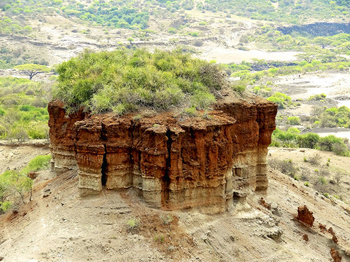 This magical place is also home to Olduvai Gorge, where the Leakeys discovered hominid remains of a 1.8-million-year-old skeleton of Australopithecus boisei, a significant link in the human evolutionary chain. In a small canyon just north of the crater, the Leakeys and their team of international archaeologists excavated the ruins of at least three different hominid species and discovered a complete series of hominid footprints estimated to be over 3.7 million years old. These fossils indicate that the area is one of the oldest hominid habitats in the world.
This magical place is also home to Olduvai Gorge, where the Leakeys discovered hominid remains of a 1.8-million-year-old skeleton of Australopithecus boisei, a significant link in the human evolutionary chain. In a small canyon just north of the crater, the Leakeys and their team of international archaeologists excavated the ruins of at least three different hominid species and discovered a complete series of hominid footprints estimated to be over 3.7 million years old. These fossils indicate that the area is one of the oldest hominid habitats in the world.
The Ngorongoro Crater and the surrounding Conservation Area are undoubtedly some of the most beautiful parts of Tanzania, steeped in history and teeming with wildlife. Besides vehicle safaris to the Ngorongoro Crater, Olduvai Gorge, and surrounding attractions, trekking through the Ngorongoro Conservation Area is becoming increasingly popular. However you choose to explore the Crater Highlands, they offer an unforgettable part of the Tanzanian experience.
Size 26 square km
Location In northern Tanzania. The gateway is 1.5 hours (140 km) west of Arusha along a newly tarred road.
To do Descend into the crater from the 600-metre-high crater rim and drive through the different climates in the crater area.
Accommodation At the edge of the crater is the Ngorongoro Rhino Lodge. You will be accommodated here during the 4-day, 5-day and 6-day safari options.

Serengeti National Park
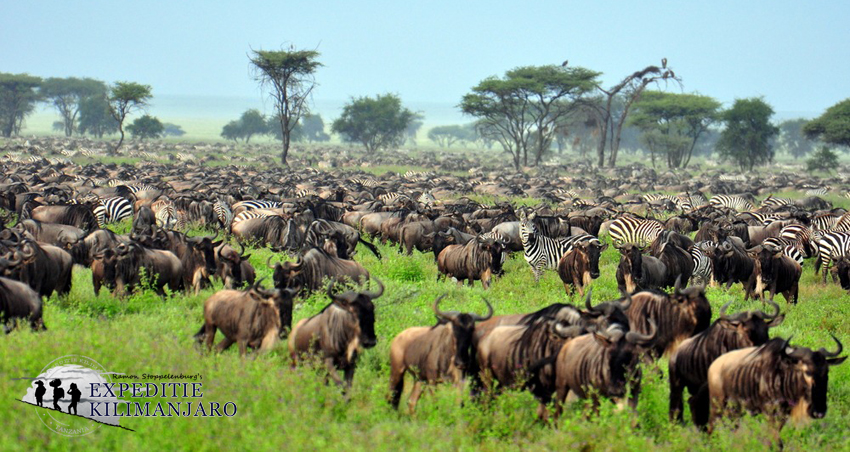
A million wildebeest, each driven by the same primal rhythm, fulfill their instinctive role in the inescapable cycle of life: a frenzied three-week period of territory conquest and mating. They survive as the fittest amidst 40-km-long columns plunging through crocodile-infested waters on their annual exodus north. This journey replenishes the species in a brief population explosion that sees over 8,000 calves born daily, before the 1,000-km pilgrimage begins anew.
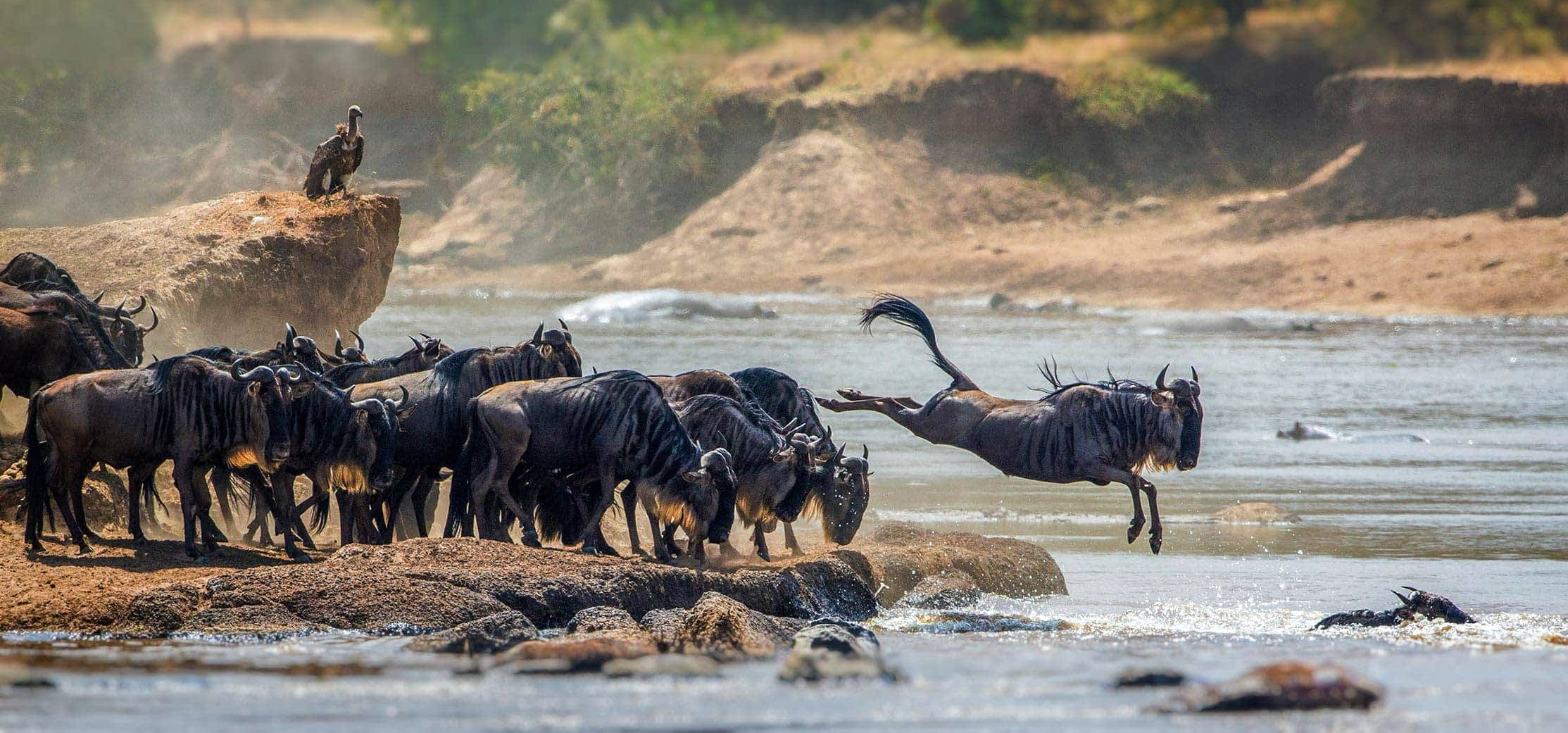
Tanzania’s oldest and most renowned national park, the Serengeti, is celebrated for its annual migration, where some six million hooves pound the open plains. Over 200,000 zebras and 300,000 Thomson’s gazelles join the wildebeests in their quest for fresh grass. Yet, even outside of this epic spectacle, the Serengeti offers some of the most mesmerizing wildlife encounters in Africa: vast herds of buffalo, solitary elephants and giraffes, and countless eland, topi, kongoni, impala, and Grant’s gazelle dotting the landscape.
The drama of predator versus prey unfolds prominently in Tanzania’s largest park. Lion prides with golden manes feast on the abundance of grazers across the plains. Solitary leopards prowl the acacia trees along the Seronera River, while a high concentration of cheetahs roams the southeastern plains. The Serengeti boasts all three African jackal species, alongside spotted hyenas and a variety of elusive small predators, from the insectivorous aardwolf to the majestic serval cat.
Beyond its iconic mammals, the Serengeti teems with diverse wildlife. Striking agama lizards and rock hyraxes dart across the park’s isolated granite koppies. Over 100 species of dung beetles thrive here, alongside more than 500 bird species ranging from the towering ostrich and peculiar secretary bird of the open grasslands to the graceful black eagles soaring above the Lobo Hills.
As enduring as its wildlife is the sense of boundless space that defines the Serengeti plains, stretching across sun-drenched savannah to a shimmering golden horizon. After the rains, these grassy plains transform into an endless green carpet adorned with wildflowers. Forested hills, towering termite mounds, rivers lined with fig trees, and acacia forests tinged orange by dust further enrich the landscape.
Despite its popularity, the Serengeti’s vastness ensures moments of solitude. You may find yourself the sole witness as a pride of lions orchestrates a hunt, their focus unwavering on their next meal.
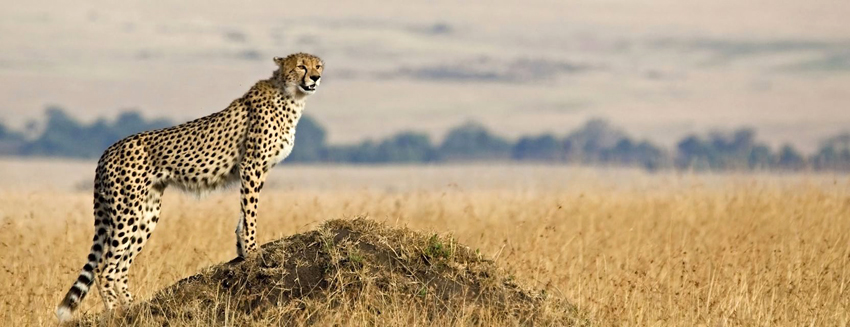
Size 14,763 km².
Located 335 km from Arusha, north of Kenya and bordering Lake Victoria to the west.
Accessibility Line and charter flights from Arusha, Lake Manyara and Mwanza. Driving from Arusha, Lake Manyara, Tarangire or the Ngorongoro Crater.
To do Air balloon safaris, Maasai rock paintings and musical rocks. Visit neighbouring Ngorongoro Crater, Olduvai Gorge, Ol Doinyo Lengai volcano and the flamingos of Lake Natron.
Best time To follow the wildebeest migration, December-July. To see predators, June-October.
Accommodation The Serengeti National Park is included in the 4-day, 5-day and 6-day safari options and you will be accommodated at the adventurous Kati Kati Tented Camp (photo) or the Heritage Tented Camp.

View the daily schedule here for:
1 day // 2 days // 3 days // 4 days // 5 days // 6 days
Step 2: add your Safari of choice to your Expedition Kilimanjaro with your reservation here.
